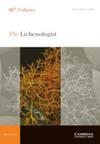Natura 2000 network enhances the protection of rare epiphytic lichens: evidence from forest sites of Central Italy
IF 1.4
4区 生物学
Q4 MYCOLOGY
引用次数: 0
Abstract
Abstract Although epiphytic lichens are widely adopted as environmental indicators, they are not yet included among the target species listed in Annex II of the Habitats Directive, to which the system of protected areas of the Natura 2000 network refers. In this work, we aim to test the effectiveness of this system, mainly designed for the conservation of other groups of species, in protecting lichen species richness. For this purpose, we considered a case study (Central Italy) with half of the territory included in protected areas. Statistical differences in species richness and lichen communities were tested between sites located in 16 Protected Areas (PA) and 11 Non-Protected Areas (NPA) using non-parametric tests, multi-response permutation procedures (MRPP), non-metric multidimensional scaling (NMDS) and Indicator Species Analysis (ISA). Despite the broad overlap between epiphytic lichen communities of NPAs and PAs and a similar number of total and common species, PAs contain a significantly higher number of nationally rare and extremely rare species, including cyanolichens. These results are also confirmed by the indicator analysis. Although the Natura 2000 network does not explicitly address the conservation of lichens, the protected areas in our study can play a role in protecting the diversity of epiphytic lichens, especially nationally rare and endangered species. However, the future inclusion of red-listed epiphytic lichens among the target species of Annex II of the Habitats Directive would be welcome to better protect these organisms on a European level.Natura 2000网络加强了稀有附生地衣的保护:来自意大利中部森林遗址的证据
虽然附生地衣作为环境指标被广泛采用,但它们尚未被列入Natura 2000网络保护区系统所参考的《生境指令》附件二的目标物种。在这项工作中,我们旨在测试该系统在保护地衣物种丰富度方面的有效性,该系统主要用于保护其他物种群。为此,我们考虑了一个案例研究(意大利中部),其中一半的领土属于保护区。采用非参数测试、多响应置换程序(MRPP)、非度量多维尺度(NMDS)和指标物种分析(ISA)等方法,对16个保护区(PA)和11个非保护区(NPA)的物种丰富度和地衣群落进行了统计差异分析。尽管国家保护区和自然保护区的附生地衣群落之间存在广泛的重叠,并且总种数和常见种数相似,但自然保护区含有大量的国家稀有和极稀有物种,包括蓝藻。这些结果也得到了指标分析的证实。虽然Natura 2000网络并没有明确地涉及地衣的保护,但我们研究的保护区可以在保护附生地衣的多样性,特别是国家珍稀和濒危物种方面发挥作用。然而,未来将附生地衣列入生境指令附件二的目标物种中,将受到欢迎,以更好地在欧洲层面上保护这些生物。
本文章由计算机程序翻译,如有差异,请以英文原文为准。
求助全文
约1分钟内获得全文
求助全文
来源期刊

Lichenologist
生物-真菌学
CiteScore
2.90
自引率
14.30%
发文量
23
审稿时长
6.0 months
期刊介绍:
The Lichenologist is the premier scientific journal devoted exclusively to the study of lichens worldwide. As the leading forum for the dissemination of new concepts and topical reviews, The Lichenologist reaches more scientists concerned with the study of lichens and lichen symbionts than any other single journal. All aspects of lichenology are considered including systematics and phylogenetics; molecular biology; ultrastructure, anatomy and morphology; secondary chemistry, effects of pollutants and use as bioindicators; biogeography. In addition to standard length research papers, the journal also publishes Short Communications and Book Reviews. A monthly issue may occasionally be devoted to papers deriving from a symposium.
 求助内容:
求助内容: 应助结果提醒方式:
应助结果提醒方式:


